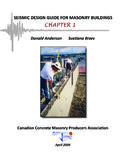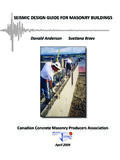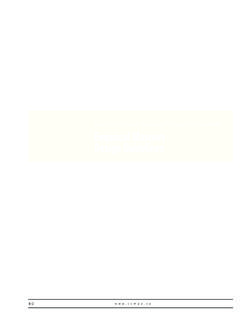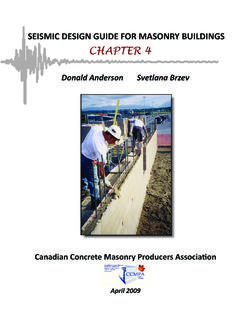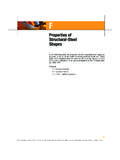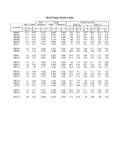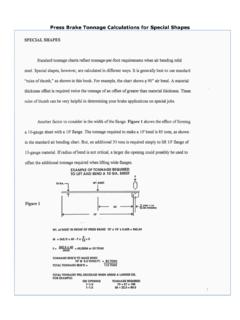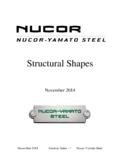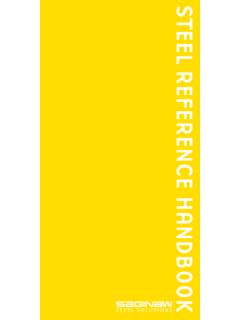Transcription of Coursing Tables, Metric Shapes and Sizes - CCMPA
1 W w w . c c m p a . c aCoursing Tables, Metric Shapes and SizesBy Gary Sturgeon, , MSc., Services Engineer, CCMPAw w w . c c m p a . c a3-1 Coursing Tables, Metric Shapes and The Anatomy of a Standard Concrete Block Masonry UnitA perspective view of a standard, hollow concrete block ma-sonry unit is shown in Figure , with associated section cuts provided in Figure These figures illustrate key elements of a concrete block masonry unit, and identify terminology commonly used in technical literature and in the field. Some relevant terms which characterize the size and shape of a concrete block masonry unit include:Faceshell: A side wall of a concrete block masonry : A cross wall which connects the faceshells, termed either as a centre web or an end web . The webs extend and are fully attached to the faceshells to the full height of a standard concrete block masonry (or Core): A hollow space (or void) extending fully through a unit.
2 The webs and faceshells are tapered, forming a tapered cell, which facilitates de-moulding of the unit during its manufac-ture. Additionally, the webs and faceshells are often flared along one cross-sectional surface (along the lower surface as made ; its upper surface as laid ), which provides a grip for handling by the mason, and a wider bed to receive mortar when laying the unit in the course immediately cell remains ungrouted in hollow, plain masonry or may be grouted in grouted masonry; or it may be grouted and contain vertical steel bar reinforcement to provide reinforced concrete masonry construction. Two-cell units are typical for hollow concrete block masonry units. Three-cell units are sometimes used for semi-solid units. In general, two-cell design offers larger cells to facilitate the placement of vertical bar reinforcement and grout.
3 (Chapter 4 discusses the terms hollow , semi-solid , and full solid units).In plan, the cell is commonly pear-shaped, or may be (or End Flange): The end of a concrete block unit may be flanged (Figures and ), or smooth (plain) (Figure ). A frogged end is an alternative term for a flanged flanged end allows the mason to grip the unit by its end webs, providing finger room . The flange may be grooved or plain. The groove is intended to help the mason compact mortar into the head joint at the block end. Flanged units are typically built into the field of a masonry element such as a ends are used where the end of the unit is exposed, such as for corner, pier, and pilaster construction. Where a plain end unit is used in lieu of a flanged end unit, the CSA Masonry Standards and the National Building Code of Canada do not differentiate any relative performances of the con-structed masonry related to issues of structure, environmental separation, fire and sound control, and other Standard Concrete Block Masonry Units, and Modular Coordination Standard Overall DimensionsRequirements for modular and basic/manufactured dimen-sions for standard concrete block masonry units used in Canada are contained in CSA Standard , Concrete Block Masonry Units , and are reproduced in table , terms modular and basic or manufactured used in the standard are synonymous with the more common-ly-used field terms nominal and actual , modular (nominal) and actual (basic or manufactured)
4 Dimensions for width, height, and length of a standard con-crete block masonry unit are also illustrated in Figure concrete block masonry units are commonly available in nominal widths of 100 mm, 150, 200, 250, and 300 mm. The typical nominal height is 200 mm; although ashlar units (also termed half-high units) have a standardized nominal height of 100 mm. The standard nominal length of a unit is 400 mm, with half-length units standardized at 200 mm. Half-high (ashlar units) and half-length units are companion units supplied to the mason by the block producer as a convenience to minimize site-cutting of full units, and to complete patterned : Overall Dimensions for Standard Concrete Block Masonry Units (Adapted from Ref. 2) Width, mm Height, mm Length, mm Modular Basic* Modular Basic* Modular Basic* 100 90 100 90 200 190 150 140 200 190 400 390 200 190 250 240 300 290* or manufacturedw w w.
5 C c m p a . c a3-2 Coursing Tables, Metric Shapes and SizesThe actual dimensions of width, height and length are 10 mm less than the nominal dimensions of a unit, respectively, to accommodate a standard 10 mm mortar joint. By doing so, modular dimensions in all three directions are is common practice when identifying or specifying concrete block masonry units to state the block nominal width, the block (course) nominal height, and the block nominal length, in this order. Hence, a 150 x 200 x 400 mm unit has: nominal overall dimensions of: 150 mm wide x 200 mm high, x 400 mm long; and, actual overall dimensions of: 140 mm wide x 190 mm high x 390 mm most commonly used units in Canada for loadbearing structural applications are the 200 and 250 mm nominal width Permissible Dimensions and Permissible VariationsRequirements for permissible dimensions, and permissible variations in dimensions for concrete block masonry units used in Canada are contained in CSA For standard concrete block masonry units, CSA requires the minimum faceshell and web thicknesses shown in table dimensions of the unit are determined by the producer or certified testing agency by appropriate sampling and physi-cally measuring units using calipers in accordance with the procedures of ASTM C 140-03, Standard Test Methods for Sampling and Testing Concrete Masonry Units and Related Units.
6 The minimum thicknesses for faceshells and webs are as-signed by the standard based upon the modular (nominal) width of the unit. They refer to the most limiting width of a tapered faceshell or web in the unit, that is, to the narrowest cross-section and to the average thicknesses mea-sured. In addition to these dimensional limits, the equivalent web thickness (the sum of the minimum web thicknesses in the unit) is assigned a minimum percentage of the overall length of the unit. This ensures that sufficient web material ex-ists to transfer imposed loads in-service from one faceshell to the other faceshell and that unit integrity is maintained during manufacture and limits on faceshell and web thicknesses ensures that the fundamental assumptions used to predict the performance of masonry elements constructed with standard concrete block units are met under the actions of structural and non-structural loads.
7 For example, CSA , Design of Masonry Struc-tures , relies on these fundamental assumptions to predict structural strength and behaviour of concrete block masonry standard concrete block masonry units, CSA also assigns limits on permissible variations in overall dimen-sions of the units, as stated in table permissible limits on unit dimensions helps to ensure quality construction. Respecting these limits assists the mason to minimize faceting (small offsets) between the faces of installed adjacent units, and to maintain the required heights and lengths of constructed concrete block masonry elements with acceptable variations in mortar joint widths and joint alignments. CSA also limits the maximum variation between units within a job lot, for a specified dimension, to not more than 2 mm. table : Minimum Widths of Faceshells and Webs for Standard Concrete Block Masonry Units (Adapted from Ref.)
8 2)Modular width of unit, mm Minimum faceshell thickness, mm Minimum web thickness, mm Minimum equivalent web thickness as a percentage (%) of length of unit100 20 20 15150 25 25 19200 30 25 19250 35 28 21300 35 30 21 table : Permissible Variations in Dimensions for Standard Concrete Block Masonry Units (Adapted from Ref. 2)Width, mm Height, mm Length, mm + , w w . c c m p a . c a3-3 Coursing Tables, Metric Shapes and SizesCCMPA producers of standard concrete block masonry units ensure that the moulds used to manufacture standard units comply with the actual unit dimensions, and the limiting faceshell and web thicknesses required by CSA Compliance with the stated dimensional tolerances in CSA is assured by appropriate manufacturing process-es, and verified by in-house quality assurance required, units can be manufactured to closer toler-ances than those permitted by CSA Producers of the desired units should be consulted before specifying more limiting Modular CoordinationBecause concrete block masonry units can be effectively and readily cut on-site, concrete block masonry structures can be constructed to virtually any dimensional layout.
9 However, there is economy in construction where cutting and fitting of units to suit are minimized. Careful planning by the designer is coordination in construction is achievable and practi-cable where:1. product component dimensions and their permissible tolerances are specified, readily achievable in production, and verifiable, and for concrete block masonry units, the relevant requirements are stated in CSA ;2. quality assurance in the manufacture of the product component is provided by way of standardized testing and required frequency of testing, and for concrete block masonry units, these requirements are provided in CSA and ASTM C 140-03 (C140 is a test standard referenced by );3. required quality of work of the assembly in which the product is included is stated, achievable, and verifiable, and for concrete block masonry construction, these requirements are provided in CSA A371, Masonry Con-struction for Buildings ; and,4.
10 On-site programs for assurance of quality of the construct-ed assembly are prudent and reasonably undertaken, as specified in project construction for modular coordination assigns overall heights, lengths, and widths of a building, and elements included in the building to multiples of the building s basic modular-sized component. In Metric modular planning for concrete block masonry construction, horizontal dimensions are typically an even multiple of 200 mm, that is, a multiple of the nominal half-length of a standard concrete block unit. In elevation, vertical dimensions are typically even multiples of a nominal full height standard concrete block unit, that is, of 200 building layouts to a 200 mm module typically include, but are not limited to:1. overall wall/pier/pilaster lengths (plan dimensions);2. overall wall/pier/pilaster heights (elevation dimensions);3.
